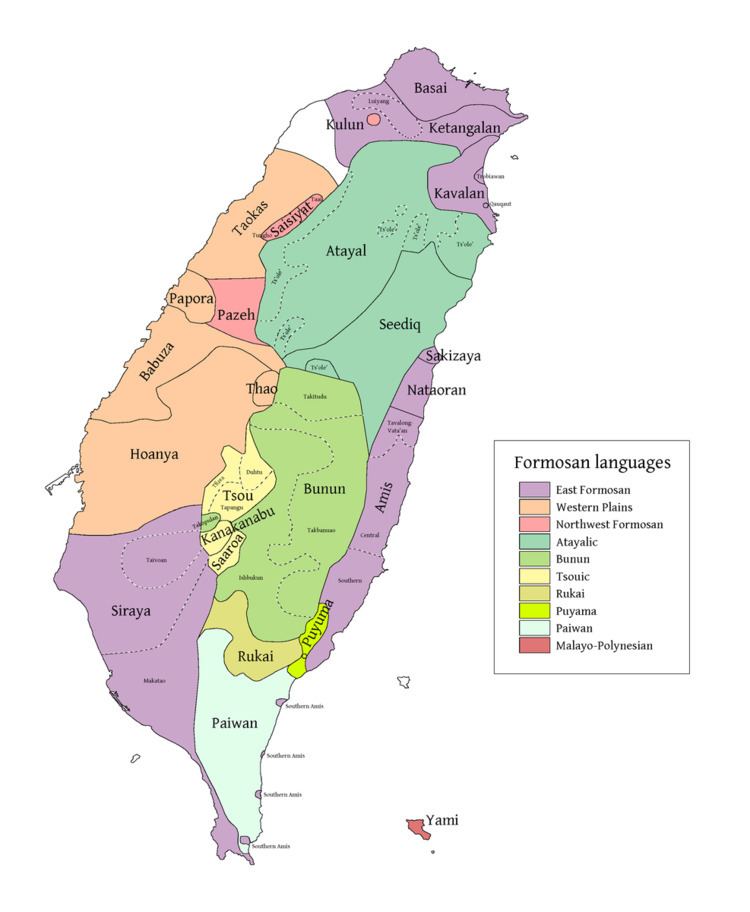Dialects Kulun | Ethnicity Pazeh people ISO 639-3 uun | |
 | ||
Language family AustronesianNorthwest FormosanPazeh | ||
Pazeh (also spelled Pazih, Pazéh) is the extinct language of the Pazeh, a Taiwanese aboriginal people. It was a Formosan language of the Austronesian languages language family. The last remaining native speaker of Pazeh proper, Pan Jin-yu, died in 2010 at the age of 96. Before her death, she offered Pazeh classes to about 200 regular students in Puli and a small number of students in Miaoli and Taichung. Kulun (sometimes also spelled Kulon) was a dialect that became extinct earlier. The insulting name "fan" was used against Plains Aborigines by the Taiwanese, and the Hoklo Taiwanese speech was forced upon Aborigines like the Pazeh. Hoklo Taiwanese has replaced Pazeh and driven it to near extinction. Aboriginal status has been requested by Plains Aboriginals.
Contents
Phonology
Pazeh has 17 consonants, 4 vowels, and 4 diphthongs (-ay, -aw, -uy, -iw).
- /t/ and /d/ do not actually share the same place of articulation; /d/ is alveolar or prealveolar and /t/ (as well as /n/) is interdental. Other coronal consonants tend to be prealveolar or post-dental.
- The distribution for the glottal stop is allophonic, appearing only between like vowels, before initial vowels, and after final vowels. It is also largely absent in normal speech
- /ɡ/ is spirantized intervocalically
- /z/ is actually an alveolar/prealveolar affricate [dz] and only occurs as a syllable onset.
- /h/ varies between glottal and pharyngeal realizations ([ħ]) and is sometimes difficult to distinguish from /x/
Although Pazeh contrasts voiced and voiceless obstruents, this contrast is neutralized in final position for labial and velar stops, where only /p/ and /k/ occur respectively (/d/ is also devoiced but a contrast is maintained). /l/ and /n/ are also neutralized to the latter. Voiceless stops are unreleased in final position.
Mid vowels ([ɛ] and [o]) are allophones of close vowels (/i/ and /u/ respectively).
/a/ is somewhat advanced and raised when adjacent to /i/. Prevocally, high vowels are semivocalized. Most coronal consonants block this, although it still occurs after /s/. Semivowels also appear post-vocally.
Phonotactics
The most common morpheme structure is CVCVC where C is any consonant and V is any vowel. Consonant clusters are rare and consist only of a nasal plus a homorganic obstruent or the glide element of a diphthong.
Intervocalic voiceless stops are voiced before a morpheme boundary (but not following one) . Stress falls on the ultimate syllable.
Sound changes
The Pazih language merged the following Proto-Austronesian phonemes (Li 2001:7).
- *C, *S > s
- *D, *Z > d
- *k, *g > k
- *j, *s > z
- *S2, *H > h
- *N, *ñ > l
- *r, *R > x
Pazih also split some Proto-Austronesian phonemes:
- *S > s (merged with *C); *S2, *H > h
- *w > ø, w
- *e > e, u
Grammar
Like Bunun, Seediq, Squliq Atayal, Mantauran Rukai, and the Tsouic languages, Pazeh does not distinguish between common nouns and personal names, whereas Saisiyat does (Li 2000). Although closely related to Saisiyat, the Pazeh language does not have the infix -um- that is present in Saisiyat.
Morphology
Pazeh makes ready use of affixes, infixes, suffixes, and circumfixes, as well as reduplication. Pazeh also has "focus-marking" in its verbal morphology. In addition, verbs can be either stative or dynamic.
There are four types of focus in Pazeh (Li 2000).
- Agent-focus (AF): mu-, me-, mi-, m-, ma-, ∅-
- Patient-focus (PF) -en, -un
- Locative-focus (LF): -an
- Referential-focus (RF): sa-, saa-, si-
The following affixes are used in Pazeh verbs (Li 2000).
The following are also used to mark aspect (Li 2000).
Affixes
The Pazih affixes below are from Li (2001:10–19).
Syntax
Although originally a verb-initial language, Pazeh often uses SVO (verb-medial) sentence constructions due to influence from Chinese.
There are four case markers in Pazeh (Li 2000).
- ki Nominative
- ni Genitive
- di Locative
- u Oblique
Pazeh has the following negators (Li 2001:46).
Pronouns
The Pazeh personal pronouns below are from Li (2000). (Note: vis. = visible, prox. = proximal)
Numerals
Pazeh and Saisiyat are the only Formosan languages that do not have a bipartite numerical system consisting of both human and non-human numerals (Li 2006). Pazeh is also the only language that forms the numerals 6 to 9 by addition (However, Saisiyat, which is closely related to Pazeh, expresses the number 6 as 5 + 1, and 9 as 10 − 1.)
The number "five" in Pazeh, xasep, is similar to Saisiyat Laseb, Taokas hasap, Babuza nahup, and Hoanya hasip (Li 2006). Li (2006) believes that the similarity is more likely because of borrowing rather than common origin. Laurent Sagart considers these numerals to be ancient retentions from Proto-Austronesian, but Paul Jen-kuei Li considers them to be local innovations. Unlike Pazeh, these Plains Aboriginal languages as well as the Atayalic languages use 2 × 4 to express the number 8. (The Atayalic languages as well as Thao also use 2 × 3 to express the number 6.) Saisiyat, Thao, Taokas, and Babuza use 10 − 1 to express 9, whereas Saisiyat uses 5 + 1 to express 6 as Pazeh does. The Ilongot language of the Philippines also derives numerals in the same manner as Pazeh does (Blust 2009:273).
Furthermore, numerals can function as both nouns and verbs in all Formosan languages, including Pazeh.
